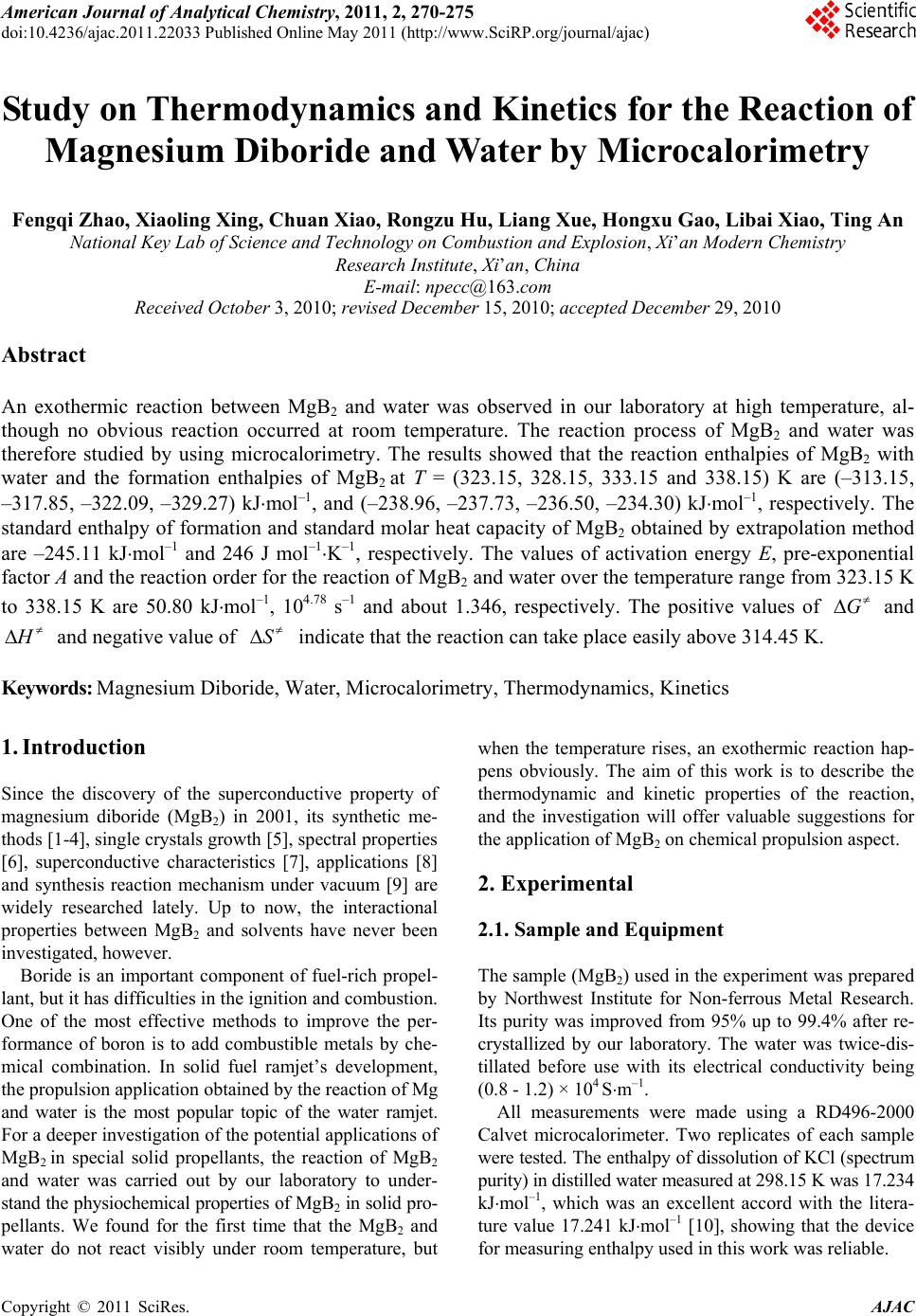
American Journal of Anal yt ical Chemistry, 2011, 2, 270-275
doi:10.4236/ajac.2011.22033 Published Online May 2011 (http://www.SciRP.org/journal/ajac)
Copyright © 2011 SciRes. AJAC
Study on Thermodynamics and Kinetics for the Reaction of
Magnesium Diboride and Water by Microcalorimetry
Fengqi Zhao, Xiaoling Xing, Chuan Xiao, Rongzu Hu, Liang Xue, Hongxu Gao, Libai Xiao, Ting An
National Key Lab of Science and Technology on Combustion and Explosion, Xi’an Modern Chemistry
Research Institute, Xi’an, China
E-mail: npecc@163.com
Received October 3, 2010; revised December 15, 2010; accepted December 29, 2010
Abstract
An exothermic reaction between MgB2 and water was observed in our laboratory at high temperature, al-
though no obvious reaction occurred at room temperature. The reaction process of MgB2 and water was
therefore studied by using microcalorimetry. The results showed that the reaction enthalpies of MgB2 with
water and the formation enthalpies of MgB2 at T = (323.15, 328.15, 333.15 and 338.15) K are (–313.15,
–317.85, –322.09, –329.27) kJmol–1, and (–238.96, –237.73, –236.50, –234.30) kJmol–1, respectively. The
standard enthalpy of formation and standard molar heat capacity of MgB2 obtained by extrapolation method
are –245.11 kJmol–1 and 246 J mol–1K–1, respectively. The values of activation energy E, pre-exponential
factor A and the reaction order for the reaction of MgB2 and water over the temperature range from 323.15 K
to 338.15 K are 50.80 kJmol–1, 104.78 s–1 and about 1.346, respectively. The positive values of G
and
and negative value of indicate that the reaction can take place easily above 314.45 K.
H
S
Keywords: Magnesium Diboride, Water, Microcalorimetry, Thermodynamics, Kinetics
1. Introduction
Since the discovery of the superconductive property of
magnesium diboride (MgB2) in 2001, its synthetic me-
thods [1-4], single crystals growth [5], spectral properties
[6], superconductive characteristics [7], applications [8]
and synthesis reaction mechanism under vacuum [9] are
widely researched lately. Up to now, the interactional
properties between MgB2 and solvents have never been
investigated, however.
Boride is an important component of fuel-rich propel-
lant, but it has difficulties in the ignition and combustion.
One of the most effective methods to improve the per-
formance of boron is to add combustible metals by che-
mical combination. In solid fuel ramjet’s development,
the propulsion application obtained by the reaction of Mg
and water is the most popular topic of the water ramjet.
For a deeper investigation of the potential applications of
MgB2 in special solid propellants, the reaction of MgB2
and water was carried out by our laboratory to under-
stand the physiochemical properties of MgB2 in solid pro-
pellants. We found for the first time that the MgB2 and
water do not react visibly under room temperature, but
when the temperature rises, an exothermic reaction hap-
pens obviously. The aim of this work is to describe the
thermodynamic and kinetic properties of the reaction,
and the investigation will offer valuable suggestions for
the application of MgB2 on chemical propulsion aspect.
2. Experimental
2.1. Sample and Equipment
The sample (MgB2) used in the experiment was prepared
by Northwest Institute for Non-ferrous Metal Research.
Its purity was improved from 95% up to 99.4% after re-
crystallized by our laboratory. The water was twice-dis-
tillated before use with its electrical conductivity being
(0.8 - 1.2) × 104 Sm–1.
All measurements were made using a RD496-2000
Calvet microcalorimeter. Two replicates of each sample
were tested. The enthalpy of dissolution of KCl (spectrum
purity) in distilled water measured at 298.15 K was 17.234
kJmol–1, which was an excellent accord with the litera-
ture value 17.241 kJmol–1 [10], showing that the device
for measuring enthalpy used in this work was reliable.